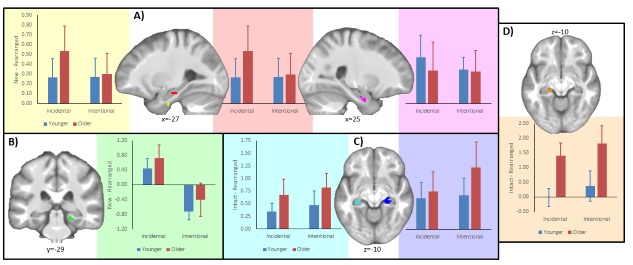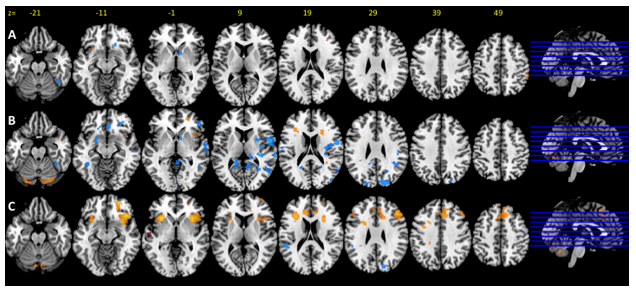Research in Dr. Kelly Giovanello’s laboratory combines behavioral, patient-based, and functional neuroimaging approaches to investigate the cognitive neuroscience of human learning and memory. A primary research focus is in elucidating the cognitive processes and neural mechanisms mediating relational memory – the form of memory which represents relationships among items or informational elements.
In everyday life, relational memory processes play a critical role in linking or binding together the various cognitive, affective, and contextual components of a learning event into an integrated memory trace. Our group is interested in specifying the cognitive and neural processes mediating relational memory in young adults and examining how these processes change with healthy aging, mild cognitive impairment due to Alzheimer’s disease, and concussion.
Considerable neuropsychological and neuroimaging work indicates that the medial temporal lobes are critical for both item memory and relational memory retrieval. However, there remain outstanding issues in the literature, namely the extent to which medial temporal lobe regions are differentiated during incidental and intentional retrieval of relational and item information, and the extent to which aging may affect these neural substrates. In a recent functional magnetic resonance imaging (fMRI) study, Dr. Giovanello and her researchers sought to address these questions.
Results indicated that, in both younger and older adults, anterior hippocampus and perirhinal cortex index incidental and intentional item retrieval in the same manner, but parahippocampal cortex differentially indexes these two forms of item retrieval (see Figure 1). In contrast, posterior hippocampus supports incidental and intentional relational retrieval in both age groups and an adjacent cluster in posterior hippocampus was recruited during both forms of relational retrieval for older but not younger adults (see Figure 1). Our findings suggest that there are both shared and distinct roles for medial temporal lobe regions in incidental and intentional retrieval of item and relational information, and further indicate that these regions may, under certain conditions, be over-recruited in healthy aging.

Figure 2, below, shows task-based fMRI data from a recent research study in our laboratory that investigated the effects of sport-related concussion, versus sport-related exposure, on the functional neural correlates of memory. Personal history of sport-related concussions has been linked to an increased likelihood of memory complaints, dementia, and early-onset Alzheimer’s disease. However, research also suggests that the cumulative burden of sub-concussive impacts (accumulative effects from numerous head impacts that do not result in concussion) is also associated with these outcomes. In Figure 2, blue signifies the effect of sport-related concussion history, orange signifies the effect of different memory loads (i.e., easy to difficult) and red represents the effect of sport-related exposure. As such, both concussion history and cumulative football participation history contribute to differential neural recruitment in memory. However, concussion history had a stronger association with our outcome measures than cumulative football participation history. This suggests that, in this population, history of concussions, rather than cumulative burden of sub-concussive impacts, may have a stronger effect on later-life neural efficiency.

 Neuroscientific research has established that the hippocampal formation, a structure within the medial temporal lobe, plays a critical role in memory for facts and events (declarative memory). Dr. Kelly Giovanello is an Associate Professor at the Department of Psychology and Neuroscience. She uses behavioral, patient-based, and functional neuroimaging approaches to investigate the cognitive neuroscience of human learning and memory.
Neuroscientific research has established that the hippocampal formation, a structure within the medial temporal lobe, plays a critical role in memory for facts and events (declarative memory). Dr. Kelly Giovanello is an Associate Professor at the Department of Psychology and Neuroscience. She uses behavioral, patient-based, and functional neuroimaging approaches to investigate the cognitive neuroscience of human learning and memory.

